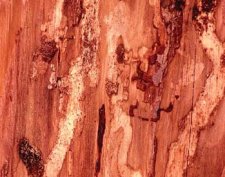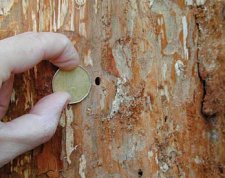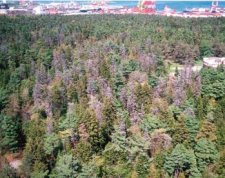Identification
Adult beetles have a flattened body, 10 to 15 mm long.Footnote 1 Footnote 2 Footnote 3 The head is black or dark brown, with a deep longitudinal groove between the antennae. The head is also covered with long, light-coloured hairs.Footnote 1 Footnote 2 Their eyes are completely divided.Footnote 2 The slender antennae are half the length of the body and are reddish brown.Footnote 1 Footnote 2 Footnote 4 Footnote 3 The pronotum bulges laterally.Footnote 5 The elytra are tan, brown, or reddish-brown with 2 or 3 longitudinal grooves.Footnote 4 The legs are dark brown or reddish-brown.Footnote 1 Footnote 2
Plant pest card - Brown spruce longhorn beetle
Host trees
Picea (main host), Abies, Pinus and Larix.Footnote 1 Footnote 2 Footnote 3 In North America, only Picea has been found infested to date.Footnote 2
Location of infestation within the tree
Larvae feed on the inner bark and sapwood along the entire stem. However, the lower portions of the bole are the most heavily infested.Footnote 2 Footnote 4 Footnote 6
Host condition
Stressed (e.g. drought, root disease), dying, recently felled, or healthy trees.Footnote 1 Footnote 7 Footnote 2 Footnote 8 Middle aged and mature spruce trees are preferred.Footnote 6
Distribution
Europe and Japan. Introduced to North America in Halifax, NS eastern Canada and efforts are being made to prevent further spread.Footnote 2
Signs and symptoms
Eggs are laid singly or in pairs in well concealed locations under bark scales or in bark crevices.Footnote 2
Larvae bore into the inner bark and excavate a network of irregular, 6 mm wide galleries, which become filled with tightly packed, fine-grained frass and short wood fibres.Footnote 2 Larval galleries lightly etch the sapwood.Footnote 2 Much of the tree's inner bark can be destroyed by these wide, irregular and meandering larval galleries.Footnote 2 Mature larvae bore "L-shaped" galleries within the sapwood. Larvae first bore into the sapwood to a depth of about 2 to 4 cm, then turn parallel to the trunk for another 3 to 4 cm.Footnote 4 These galleries end in an oval-shaped pupal chamber.Footnote 2
Pupation occurs in the spring either in the bark, between the sapwood and bark or in the sapwood. Pupae lie in a vertical position with their heads pointed upward.Footnote 8 The wood may be stained from the associated Ophiostoma fungi.Footnote 2
Adults exit through oval or circular exit holes that are 4 to 6 mm in diameter, which may or may not be plugged with coarse sawdust.Footnote 2 Attacked trees produce excessive white resin down the length of the trunk.Footnote 2 Trees may be reinfested over subsequent years.Footnote 2 Infested tree crowns exhibit progressive yellowing, browning and loss of needles.Footnote 2 Once the tree has died, the remaining foliage changes to reddish-brown.Footnote 2

A - Adult T. fuscum (10 to 15 mm long).

B - Resin flowing from tree attacked by T. fuscum.

C - Resin flowing from infested tree.

D - T. fuscum larva.

E - Irregular shaped T. fuscum larval galleries.

F - T. fuscum larval galleries and oval exit hole (4 to 6 mm wide). Note fine-grained frass in larval galleries.

G - Stand mortality caused by T. fuscum.
Photo credits
- A Klaus Bolte, Natural Resources Canada, Canadian Forest Service
- B Canadian Food Inspection Agency, Dartmouth
- C Bob Guscott, Nova Scotia Department of Natural Resources
- D Stephanie Sopow, Natural Resources Canada, Canadian Forest Service
- E Ken Harrison, Natural Resources Canada, Canadian Forest Service
- F Tom Prest, Canadian Food Inspection Agency
- G Bob Guscott, Nova Scotia Department of Natural Resources